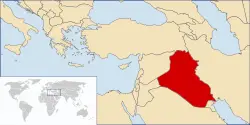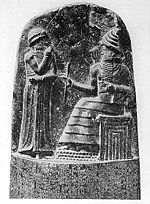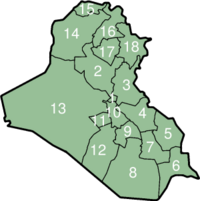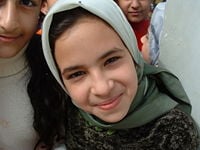Difference between revisions of "Iraq" - New World Encyclopedia
Mike Butler (talk | contribs) (Iraq importing) |
({{Contracted}}) |
||
| Line 1: | Line 1: | ||
| − | {{Claimed}} | + | {{Claimed}}{{Contracted}} |
{{Infobox_Country or territory | {{Infobox_Country or territory | ||
Revision as of 15:23, 1 May 2007
| جمهورية العراق Jumhūrīyat al-`Irāq كۆماری عێراق `Îraqê Republic of Iraq | |||||
| |||||
| Motto: الله أكبر (Arabic) "Allahu Akbar" (transliteration) "God is Great" | |||||
| Anthem: Mawtini (new) Ardh Alforatain (previous)1 | |||||
| Capital | Baghdad2 33°20′N 44°26′E | ||||
|---|---|---|---|---|---|
| Largest city | capital | ||||
| Official languages | Arabic, Kurdish | ||||
| Government | Developing parliamentary democracy | ||||
| - President | Jalal Talabani | ||||
| - Prime Minister | Nouri al-Maliki | ||||
| Independence | |||||
| - from the Ottoman Empire | October 1 1919 | ||||
| - from the United Kingdom | October 3 1932 | ||||
| Area | |||||
| - Total | 438,317 km² (58th) 169,234 sq mi | ||||
| - Water (%) | 1.1 | ||||
| Population | |||||
| - 2006 estimate | 26,783,3834 | ||||
| - Density | 66/km² 171/sq mi | ||||
| GDP (PPP) | 2005 estimate | ||||
| - Total | $89.8 billion | ||||
| - Per capita | $3,600 | ||||
| Currency | Iraqi dinar (IQD)
| ||||
| Time zone | AST (UTC+3) | ||||
| - Summer (DST) | ADT (UTC+4) | ||||
| Internet TLD | .iq | ||||
| Calling code | +964 | ||||
The Republic of Iraq[1] (conventional short form: Iraq) (Arabic: العراق ▶ transliteration: 'al-‘Irāq,Turkish: Irak, Kurdish: عيَراق), is a country in Southwest Asia spanning most of Mesopotamia as well as the northwestern end of the Zagros mountain range and the eastern part of the Syrian Desert. It shares borders with Kuwait and Saudi Arabia to the south, Jordan to the west, Syria to the northwest, Turkey to the north, and Iran to the east. It has a very narrow section of coastline at Umm Qasr on the Persian Gulf.
Modern-day Iraq covers a large area of Mesopotamia, which is considered one of the cradles of civilization. It was on the banks of the Tigris, which passes through the capital Baghdad, that writing is believed to have been born. During its long history, it has been part of the Persian, Ottoman and British empires.
Today, Iraq is a developing nation that is the focus of increased attention from the West because of the Iraq War.
Name
There are several suggested origins for the name Iraq. One dates to the Sumerian city of Uruk (or Erech); another posits that Iraq comes from the Aramaic language, meaning "the land along the banks of the rivers;" another, that Iraq refers to the root of a palm tree numerous in the country.
Under the Persian Sassanid dynasty, there was a region called "Erak Arabi," referring to the part of the south western region of the Persian Empire that is now part of southern Iraq. The name Al-Iraq was used by the Arabs themselves, from the 6th century, for the land Iraq covers.
Pronunciation of Iraq - (1) [ɪ.ˈɹɑ(ː)k], (2) [ɪ.ˈɹæk], (3) [aɪ.ˈɹæk] (1) is the preferred pronunciation in most dictionaries, and the only pronunciation listed in the Oxford English Dictionary. MQD lists (2) first. (3) is considered uneducated or unacceptable to some. It is the pronunciation which is least like the original Arabic pronunciation [ʕiˈrɑːq].
History
Ancient Mesopotamia
Iraq was historically known as Mesopotamia, which, in Greek, literally means "between the rivers". It was home to the world's first known civilization, the Sumerian culture, which was followed by the Akkadian, Babylonian, and Assyrian cultures, whose influence extended into neighboring regions as early as 5000 B.C.E. These civilizations produced the earliest writing and some of the first sciences, mathematics, laws and philosophies of the world; hence its common epithet, the "Cradle of Civilization". Ancient Mesopotamian civilization dominated other civilizations.
In the sixth century B.C.E., the Neo-Babylonian Empire was conquered by Cyrus the Great and thus Mesopotamia was incorporated in the Achaemenid Persian Empire for nearly four centuries, before it was conquered again by Alexander the Great, and then remained under Hellenistic rule for nearly two centuries. A Central Asian tribe of ancient Iranian peoples known as the Parthians then annexed the region, followed by the Sassanid Persians. The region remained as a province of the Persian Empire for nine centuries, until the 7th century.
Arab Empire
Beginning in the seventh century AD, Islam spread to what is now Iraq during the Islamic conquest of Persia, led by the Muslim Arab commander Khalid ibn al-Walid. Under the Rashidun Caliphate, the prophet Mohammed's cousin and son-in-law Ali moved his capital to Kufa "fi al-Iraq" when he became the fourth caliph. The Umayyad Caliphate, ruling from Damascus in the 7th century, ruled the province of Iraq.
The city of Baghdad was built, in Iraq, in the 8th century as the capital of the Abbasid Caliphate, and became the leading city of the Arab and Muslim world for five centuries. Baghdad was the largest multicultural city of the Middle Ages, peaking at a population of more than a million, and was the centre of learning during the Islamic Golden Age, until its eventual destruction during the sack of Baghdad in the 13th century.
Mongol Conquest
In 1257 Hulagu Khan amassed an unusually large army, perhaps ten percent of all available Mongol fighters, for the purpose of conquering Baghdad. When they arrived at the Islamic capital, Hulagu demanded surrender but the caliph refused. This angered Hulagu, and, consistent with Mongol strategy of discouraging resistance, Bagdhad was decimated. Estimates of the numbers of dead range from 200,000 to a million.
The Grand Library of Baghdad (Arabic بيت الحكمة Bayt al-Hikma, lit., House of Wisdom), containing countless precious historical documents was destroyed along with the Abbasid Caliphate. The city would never regain its status as major center of culture and influence.
Ottoman Empire
Later, the Ottoman Turks took Baghdad from the Persians in 1535. The Ottomans lost Baghdad to the Iranian Safavids in 1509, and took it back in 1632. Ottoman rule lasted until World War I, during which the Ottomans sided with Germany and the Central Powers.
World War I
During World War I the Ottomans were driven from much of the area by the United Kingdom during the dissolution of the Ottoman Empire. The British lost 92,000 soldiers in the Mesopotamian campaign. Ottoman losses are unknown but the British captured a total of 45,000 prisoners of war. By the end of 1918 the British had deployed 410,000 men in the area, though only 112,000 were combat troops.
Partitioning
During World War I the British and French divided the Middle East in the Sykes-Picot Agreement. The Treaty of Sèvres, which was ratified in the Treaty of Lausanne, led to the advent of the modern Middle East and Republic of Turkey. The League of Nations granted France mandates over Syria and Lebanon and granted the United Kingdom mandates over Iraq and Palestine (which then consisted of two autonomous regions: Palestine and Transjordan). Parts of the Ottoman Empire on the Arabian Peninsula became parts of what are today Saudi Arabia and Yemen.
British Mandate of Mesopotamia
At the end of World War I, the League of Nations granted the area to the United Kingdom as a mandate. It was formed out of three former Ottoman vilayets (regions): Mosul, Baghdad, and Basra.
For three out of four centuries of Ottoman rule, the vilayets of Baghdad, Mosul, and Basra were administered from Baghdad. During the British mandate, the country was ruled by British colonial administrators who used the British armed forces to put down rebellions against British rule. They selected the Hashemite king, Faisal, who had been forced out of Syria by the French, to be their client ruler. The government and ministries' officers were likewise appointed by British authorities, selected from the Sunni Arab elite in the region.[2]
Hashemite monarchy
Iraq was granted independence in 1932 on the urging of King Faisal, though the British retained military bases and transit rights for their forces. King Ghazi of Iraq ruled as a figurehead after King Faisal's death in 1933, while undermined by attempted military coups (dictatorships), until his death in 1939. Iraq was invaded by the United Kingdom in 1941, for fear that the government of Rashid Ali might cut oil supplies to Western nations, and because of his strong idealogical leanings to Nazi Germany. A military occupation followed the restoration of the Hashemite monarchy, and the occupation ended on October 26, 1947. The rulers during the occupation and the remainder of the Hashemite monarchy were Nuri al-Said, the autocratic prime minister, who also ruled from 1930-1932, and 'Abd al-Ilah, an advisor to the king Faisal II.
Republic of Iraq
The reinstated Hashemite monarchy lasted until 1958, when it was overthrown by a coup d'etat of the Iraqi Army, known as the 14 July Revolution. The coup brought Brigadier General Abdul Karim Qassim to power. He withdrew from the Baghdad Pact and established friendly relations with the Soviet Union, but his government lasted only until 1963, when it was overthrown by Colonel Abdul Salam Arif. Salam Arif died in 1966 and his brother, Abdul Rahman Arif, assumed the presidency. In 1968, Rahman Arif was overthrown by the Arab Socialist Baath Party. This movement gradually came under the control of Saddam Hussein al-Majid al Tikriti, who acceded to the presidency and control of the Revolutionary Command Council (RCC), then Iraq's supreme executive body, in July 1979, while killing off many of his opponents.
Saddam Hussein
Saddam's regime lasted throughout the Iran-Iraq War (1980–1988), during which Iraqi forces attacked Iranian soldiers and civilians with chemical weapons. The war ended in stalemate. This period is notorious for the Saddam regime's human rights abuses, for instance, during the Al-Anfal campaign.[3][4][5]
Osirak (also spelled Osiraq) was constructed by the Iraqi government at the Al Tuwaitha Nuclear Research Center, 18 km (11 miles) south-east of Baghdad in 1977. It was a 40 MW light-water nuclear materials testing reactor (MTR). Israeli aircraft bombed it in 1981, in order to prevent the regime from using the reactor for creation of nuclear weapons.
In 1990 Iraq invaded Kuwait, resulting in the Gulf War and economic sanctions imposed by the United Nations at the behest of the U.S. The economic sanctions were intended to compel Saddam to dispose weapons of mass destruction.[6] Critics estimate that more than 500,000 Iraqi children died as a result of the sanctions.[7] The U.S. and the UK declared no-fly zones over Kurdish northern and Shiite southern Iraq to oversee the Kurds and southern Shiites.
2003 invasion by American-led Coalition Forces
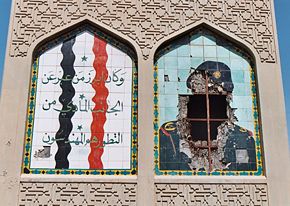
Iraq was invaded in March 2003 by a United States-organized coalition, with the stated reason that Iraq had not abandoned its nuclear and chemical weapons development program according to United Nations resolution 687. When Iraq invaded Kuwait, the United Nations Security Council, under Chapter VII of the United Nations Charter, adopted resolution 678, authorizing armed action against Iraq. Resolution 678 contained vague language authorizing U.N. member states to use "all necessary means" to "restore international peace and security in the area." After Iraq was expelled from Kuwait the United Nations passed a cease-fire resolution 687. The agreement included provisions obligating Iraq to discontinue its nuclear weapons program. The United States asserted that because Iraq was in "material breach" of resolution 687, the armed forces authorization of resolution 678 was revived.
The public justifications, given for invasion including purported Iraqi government links to Al Qaeda, claimed that Iraq had weapons of mass destruction, and that they had the opportunity to remove an oppressive dictator from power, and to bring democracy to Iraq. In his State of Union Address on January 29, 2002, the American President George W. Bush declared that Iraq was a member of the "axis of evil"; and that, like North Korea and Iran, Iraq's attempt to acquire weapons of mass destruction gave credentials to the claim that the Iraqi government posed a serious threat to America's national security. He added, "Iraq continues to flaunt its hostilities toward America and to support terror. The Iraqi regime has plotted to develop anthrax, and nerve gas, and nuclear weapons for over a decade... This is a regime that agreed to international inspections—then kicked out inspectors. This is a regime that has something to hide from the civilized world... By seeking weapons of mass destruction, these regimes [Iran, Iraq and North Korea] pose a grave and growing danger. They could provide these arms to terrorists, giving them the means to match their hatred."[8]
Post-invasion Iraq
The United States established the Coalition Provisional Authority to govern Iraq. Government authority was transferred to an Iraqi Interim Government in 2004 and a permanent government was elected in October 2005. More than 140,000 Coalition troops remain in Iraq.
Studies have placed the number of civilians deaths as high as 655,000 (see The Lancet study), although most studies have put the number much lower: the Iraq Body Count project has a figure of less than 10% of The Lancet Study. The website of the Iraq body count however states, "Our maximum therefore refers to reported deaths - which can only be a sample of true deaths unless one assumes that every civilian death has been reported. It is likely that many if not most civilian casualties will go unreported by the media." [3].
After the invasion, al-Qaeda took advantaged of the insurgency to entrench itself in the country[9] concurrently with a Arab-Sunni led insurgency and sectarian violence. In 2006 Foreign Policy Magazine named Iraq as the fourth most unstable nation in the world.
On December 30, 2006, Saddam Hussein was hanged. [4] Hussein's half-brother and former intelligence chief Barzan Hassan and former chief judge of the Revolutionary Court Awad Hamed al-Bandar were likewise executed on January 15, 2007; [5] as was Taha Yassin Ramadan, Saddam's former deputy and former vice-president (originally sentenced to life in prison but later to death by hanging), on March 20, 2007. Ramadan was the fourth and last man in the al-Dujail trial to die by hanging for crimes against humanity. [6]
Iraqi diaspora
The dispersion of native Iraqis to other countries is known as the Iraqi diaspora. There have been many large-scale waves of emigration from Iraq, beginning early in the regime of Saddam Hussein and continuing through to 2007. The UN High Commission for Refugees has estimated that nearly two million Iraqis have fled the country in recent years, mostly to Jordan and Syria. [7] Although some expatriates returned to Iraq after the 2003 invasion, the flow had virtually stopped by 2006. [8]
Government
Politics
Iraq was under Baath Party rule from 1968 to 2003; in 1979 Saddam Hussein took control and remained president until 2003 after which he was unseated by a US-led invasion.
On October 15, 2005, more than 63% of eligible Iraqis came out across the country to vote on whether to accept or reject the new constitution. On October 25, the vote was certified and the constitution passed with a 78% overall majority, with the percentage of support varying widely between the country's territories.[10] The new constitution had overwhelming backing among the Shia and Ķurdish communities, but was overwhelmingly rejected by Arab Sunnis. Three majority Arab Sunni provinces rejected it (Salah ad Din with 82% against, Ninawa with 55% against, and Al Anbar with 97% against).
Under the terms of the constitution, the country conducted fresh nationwide parliamentary elections on December 15 to elect a new government. The overwhelming majority of all three major ethnic groups in Iraq voted along ethnic lines, turning this vote into more of an ethnic census than a competitive election, and setting the stage for the division of the country along ethnic lines.
Iraqi politicians have been under significant threat by the various factions that have promoted violence as a political weapon. The ongoing violence in Iraq has been incited by an amalgam of religious extremists that believe an Islamic Caliphate should rule, old sectarian regime members that had ruled under Saddam that want back the power they had, and Iraqi nationalists that are fighting the U.S. military presence.
Minority politics
There are a number of ethnic minority groups in Iraq: Kurds, Assyrians, Mandeans, Iraqi Turkmen, Shabaks and Roma. These groups have not enjoyed equal status with the majority Arab populations throughout Iraq's eighty-five year history. Since the establishment of the "no-fly zones" following the Gulf War of 1990-1991, the situation of the Kurds has changed as they have established their own autonomous region. The remainder of these ethnic groups continue to suffer discrimination on religious or ethnic grounds.
Governorates
Iraq is divided into eighteen governorates (or provinces) (Arabic: muhafadhat, singular - muhafadhah, Kurdish: پاریزگه Pârizgah). The governorates are subdivided into qadhas (or districts).
|
|
The new constitution of Iraq provides for regions to be created by combining one or more governorates. There is currently only one Region in existence - Iraqi Kurdistan - and there are proposals for one or more further regions to be created in the south.
Geography
At 168,743 sq.mi (437,072 km²), Iraq is the 58th-largest country in the world, after Morocco. It is comparable in size to the US state of California, and somewhat larger than Paraguay.
Large parts of Iraq consist of desert, but the area between the two major rivers (Euphrates and Tigris) is fertile, with the rivers carrying about 60 million cubic metres (78 million cu. yd) of silt annually to the delta. The north of the country is largely mountainous, with the highest point being a 3,611 metres (11,847 ft) point, unnamed on the map opposite, but known locally as Cheekah Dar (black tent). Iraq has a small coastline with the Persian Gulf. Close to the coast and along the Shatt al-Arab (known as arvandrūd: اروندرود among Iranians) there used to be marshlands, but many of these were drained in the 1990s.
The local climate is mostly desert with mild to cool winters and dry, hot, cloudless summers. The northern mountainous regions experience cold winters with occasional heavy snows, sometimes causing extensive flooding. The capital of Baghdad is situated in the centre of the country, on the banks of the Tigris. Other major cities include Basra in the south and Mosul in the north.
While its proven oil reserves of 112 billion barrels ranks Iraq second in the world behind Saudi Arabia, the United States Department of Energy estimates that up to 90 percent of the country remains unexplored. Unexplored regions of Iraq could yield an additional 100 billion barrels. Iraq's oil production costs are among the lowest in the world. However, only about 2,000 oil wells have been drilled in Iraq, compared to about 1 million wells in Texas alone.[11]
Economy
Iraq's economy is dominated by the oil sector, which has traditionally provided about 95 percent of foreign exchange earnings. In the 1980s financial problems caused by massive expenditures in the eight-year war with Iran and damage to oil export facilities by Iran led the government to implement austerity measures, borrow heavily, and later reschedule foreign debt payments. Iraq suffered economic losses from the war of at least US$100 billion. After hostilities ended in 1988, oil exports gradually increased with the construction of new pipelines and restoration of damaged facilities. A combination of low oil prices, repayment of war debts (estimated at around US$3 billion a year) and the costs of reconstruction resulted in a serious financial crisis which was the main short term motivation for the invasion of Kuwait.
On November 20 2004, the Paris Club of creditor nations agreed to write off 80% ($33 billion) of Iraq's $42 billion debt to Club members. Iraq's total external debt was around $120 billion at the time of the 2003 invasion, and had grown by $5 billion by 2004. The debt relief will be implemented in three stages: two of 30% each and one of 20%.[12]
At the end of 2005, and in the first half of 2006, Iraq implemented a restructuring of about $20 billion of commercial debt claims on terms comparable to that of its November 2004 Paris Club agreement (i.e. with an 80% writeoff). Iraq offered to its larger claimants a U.S. dollar denominated bond maturing in 2028. Smaller commercial claimants received a cash settlement of comparable value.
Reconstruction
Reconstruction of Iraq has been difficult mainly due to the amount of damage done to Iraq's basic infrastructure, the influx of the US invasion and strife among factions within the native populace. Large-scale reconstruction efforts have had, at best, limited success.
Demography
A July 2006 estimate of the total Iraqi population is 26,783,383.
Seventy-four percent of Iraq's population are Arabs; the other major ethnic groups are the Kurds at 22-24%, Assyrians, Iraqi Turkmen and others (5%), who mostly live in the north and northeast of the country. Other distinct groups are Persians and Armenians (possible descendants of the ancient Mesopotamian culture). About 25,000–60,000 Marsh Arabs live in southern Iraq.
Arabic and Kurdish are official languages. Assyrian and Turkmen are official languages in areas where the Assyrians and Iraqi Turkmen are located respectively. Armenian and Persian are also spoken but to a lesser extent. English is the most commonly spoken Western language.
Ethnic Composition:
- Ethnic groups: Arab, 70–74%; Kurdish, 22-24%; Turkoman, Assyrian or other 5%.
- Religions: Muslim, 97%; Christian or other, 3%.
Proportions: There are no official figures available, mainly due to the highly politically charged nature of the subject. Source: Britannica: Shi'a 60%, Sunni 40% Source: CIA World Fact Book: Shi'a 60%-65%, Sunni 32%-37%
- Shi'a: mostly Arabs some Turkmen and Faili Kurds almost all are Twelver school
- Sunni: composed of Arabs, Turkmen who are Hanafi school and Kurds who are Shafi school
According to most western sources the majority of Iraqis are Shi'ite Arab Muslims (around 60%), and Sunnis represent about 40% of the population made up of Arabs, Kurds and Turkmen. Sunnis hotly dispute these figures, including an ex-Iraqi Ambassador,[13] referring to American sources.[14] They claim that many reports or sources only include Arab Sunnis as 'Sunni', missing out the Kurdish and Turkmen Sunnis. Some argue that the 2003 Iraq Census shows that Sunnis were a slight majority.[15] Ethnic Assyrians (most of whom are adherents of the Chaldean Catholic Church and the Assyrian Church of the East) account for most of Iraq's sizable Christian population, along with Armenians. Bahá'ís, Mandaeans, Shabaks, and Yezidis also exist. Most Kurds are Sunni Muslims, although the Faili (Feyli) Kurds are largely Shi'a.
Culture
In the most recent millennium, what is now Iraq has been made up of five cultural areas: Kurdish in the north centered on Arbil, Sunni Islamic Arabs in the center around Baghdad, Shi'a Islamic Arabs in the south centered on Basra, the Assyrians, a Christian people, living in various cities in the north, and the Marsh Arabs, a nomadic people, who live on the marshlands of the central river. Markets and bartering are the common form of trade.
Music
Iraq is known primarily for an instrument called the oud (similar to a lute) and a rebab (similar to a fiddle); its stars include Ahmed Mukhtar and the Assyrian Munir Bashir. Until the fall of Saddam Hussein, the most popular radio station was the Voice of Youth. It played a mix of western rock, hip hop and pop music, all of which had to be imported via Jordan due to international economic sanctions. Iraq has also produced a major pan-Arab pop star-in-exile in Kazem al Saher, whose songs include Ladghat E-Hayya, which was banned for its racy lyrics.
Gallery
- Hatra ruins.jpg
Hatra ruins
Boat on the Euphrates River
See also
- Reconstruction of Iraq
- Baghdad Renaissance Plan
- Economy: Iraq Stock Exchange, Iraqi Dinar, Economy of Iraq
- Events: 2005 in Iraq, 2004 in Iraq, 2003 Invasion of Iraq, Post-invasion Iraq, 2003–present, Iraqi insurgency, Iraq War
- Geography: List of places in Iraq, Communications of Iraq, Transportation in Iraq
- Groups: Kurds, Shiites, Sunni, Assyrians, Arab Tribes in Iraq, Maslawi
- Ayad Rahim, an Iraqi-American journalist who reports on Middle East affairs
- Politics: Politics of Iraq, Iraq and Democracy, New Iraqi Army, Foreign relations of Iraq, Human rights violations in Iraq, Iraqi insurgency, Civil war in Iraq, M. Ismail Marcinkowski, Religion and Politics in Iraq. Shiite Clerics between Quietism and Resistance, with a foreword by Professor Hamid Algar of the University of California at Berkeley. Singapore: Pustaka Nasional, 2004 (ISBN 9971-77-513-1)
- History: List of Kings of Iraq, List of Presidents of Iraq, List of Prime Ministers of Iraq, British Mandate of Iraq, History of the Jews in Iraq, Iran-Iraq War, History of astrology, Fertile Crescent, Mesopotamia, Babylon
- Literature: Epic of Gilgamesh, Enuma Elish, Atra-Hasis
- Others: Postage stamps and postal history of Iraq, Gay rights in Iraq, Mesopotamian mythology
- Mass graves in Iraq
ReferencesISBN links support NWE through referral fees
- ↑ Conventional long form: Republic of Iraq - conventional short form: Iraq - local long form: Al Jumhuriyah al Iraqiyah - local short form: Al Iraq (source:CIA World Factbooc)
- ↑ Tripp, Charles:A History of Iraq,Cambridge:Cambridge University Press,2000
- ↑ Black, George [July 1993]. Genocide in Iraq : the Anfal campaign against the Kurds / Middle East Watch.. New York • Washington • Los Angeles • London: Human Rights Watch. ISBN 1-56432-108-8. Retrieved 2007-02-10.
- ↑ Hiltermann, Joost R. [February 1994]. Bureaucracy of repression : the Iraqi government in its own words / Middle East Watch.. New York • Washington • Los Angeles • London: Human Rights Watch. ISBN 1564321274. Retrieved 2007-02-10.
- ↑ "Charges against Saddam dropped as genocide trial resumes", AFP, 2007
- ↑ (April 8, 1991), "UN Security Council Resolution 687", MidEast Web, Accessed Sep 17 2006
- ↑ Hay Brown jr, Matthew, (October 23, 2000), "Iraqi Sanctions: Without Medicine And Supplies, The Children Die", Common Dreams News Centre, Accessed Sep 17 2006
- ↑ http://www.whitehouse.gov/news/releases/2002/01/20020129-11.html,The President State of Union Address, January 29,2002,Washington, D.C.
- ↑ http://news.bbc.co.uk/2/hi/americas/5329350.stm
- ↑ Wagner, Thomas, (October 25, 2005), "Iraq's Constitution Adopted by Voters", ABC News, Accessed Sep 17 2006
- ↑ US Department of Energy Information
- ↑ Bohsem, Guido & Somerville, Glen, (November 20, 2004), "G7, Paris Club Agree on Iraq Debt Relief", Reuters, Accessed Sep 17 2006
- ↑ "Iraqis By the Numbers" by FARUQ ZIADA [1]
- ↑ Map on the distribution of religious groups, from the Baker—Hamilton Committee report, page 102
- ↑ "Iraq 2003 Census: Sunnis 59% , Shiites 40%"; by Mohammed Alomari (faair.org) [2]
Further reading
- Interview with Refugees International's Sean Garcia on the plight of hundreds of thousands of Iraqi refugees [9]
- Shadid, Anthony 2005. Night Draws Near. Henry Holt and Co., NY, USA. ISBN 0-8050-7602-6
- Hanna Batatu, "The Old Social Classes and the Revolutionary Movements of Iraq", Princeton: Princeton University Press, 1978
- Iraq was one of the major settings for the John J. Rust science fiction novel "Epsilon"
- A Dweller in Mesopotamia, being the adventures of an official artist in the garden of Eden, by Donald Maxwell, 1921. (a searchable facsimile at the University of Georgia Libraries; DjVu & layered PDF format)
- By Desert Ways to Baghdad, by Louisa Jebb (Mrs. Roland Wilkins) With illustrations and a map, 1908 (1909 ed). (a searchable facsimile at the University of Georgia Libraries; DjVu & layered PDF format)
External links
Government
- Iraqi Government official government site
- New Iraqi government structure (PDF) (As of July 17, 2006)
- Kurdistan Regional Government
- Ministry of Industry and Minerals
Overviews
- Encarta Encyclopedia
- Baghdad's Golden Period
- al-Bab - Iraq
- Encyclopaedia Britannica Iraq Country Page
- BBC News Country Profile - Iraq
- CIA World Factbook - Iraq
- US State Department - Iraq includes Background Notes, Country Study and major reports
- Read Congressional Research Service (CRS) Reports regarding Iraq
- Iraq Country Profile from Reuters AlertNet
- Country Briefing: Iraq from The Economist
News
- Focus on Iraq Daily News on Iraq
- Iraq News and Iraqi views from Electronic Iraq
- News in Depth from the Financial Times
- Diplomacy Monitor-Iraq
- IPS Inter Press Service Independent news about Iraq
- Iraqis react with joy, anger to Hussein death sentence CNN story on Hussein's death sentence
Other
- Juan Cole, a leading scholar and public intellectual
- The Ground Truth Project — A series of exclusive interviews and other resources capturing the voices of Iraqis, aid workers, military personnel and others who have spent significant time on-the-ground in Iraq.
- Travel guide to Iraq from Wikitravel
- Education for Peace in Iraq Center (EPIC) — A Washington DC-based nonprofit organization promoting a free and secure Iraq
- Amnesty International Report on Iraq
- Coalition Provisional Authority Now-defunct occupation authority; site is archived
- Iraq Law from the University of Pittsburgh’s Jurist project
- 1900 - 2000 a history of Iraq
- US Embassy in Baghdad, Iraq
- Iraqi Familiarization Guide - (546 kilobyte PDF file)


